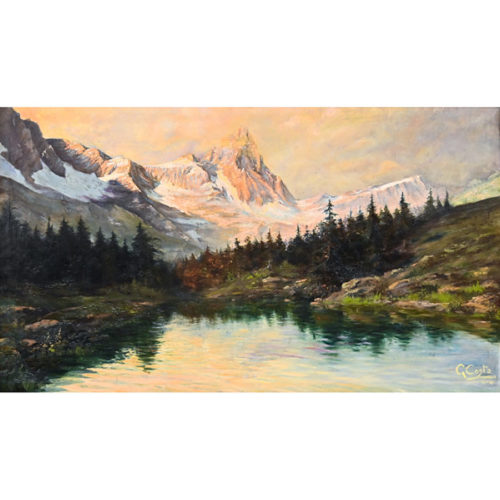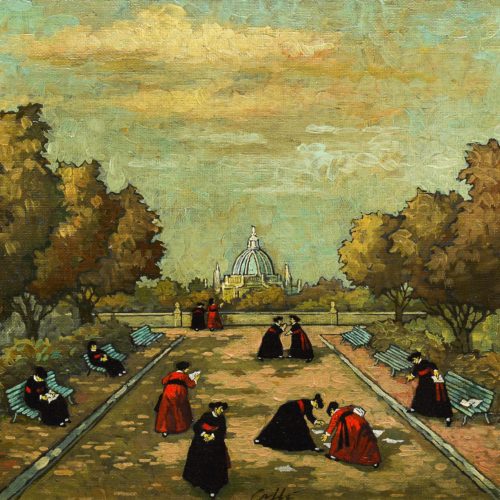"The Matterhorn with the blue lake" oil on canvas from the early 1920s by Giovanni Battista Costa (Rapallo 1858 - Genoa 1838).
The painting has been restored.
Giovanni Battista Costa was born in Rapallo in 1858 in a wealthy family and dedicated his entire life to art. He participated, since 1879, in the exhibitions of the Promoting Society of Fine Arts in Genoa and in numerous other important Italian expositions, exhibiting, until 1921, over 100 paintings, mainly landscapes, seascapes and portraits.
In 1895 he was appointed Academic of Merit of Ligustica, where he, too, teached.
He began his artistic studies at the Ligustica Academy (and partly in Rome), soon going from a painting linked to tradition to the execution of works from life, probably under the guidance of Tammar Luxoro director, from 1874, of the new Landscape School.
Consequently, the links with the Genoese Gray School, the Rivara School (in Piedmont) and the Tuscan Macchiaiolo movement appear to be close.
The analysis of some of his works lead us to bring Costa closer to some Lombard painters of the 19th century: for example Carcano, especially for the softness of the colours.
He takes part in numerous national exhibitions: awarded in 1897 in Venice, he participates in the National Exhibition of Fine Arts in Turin in 1898; in 1906 we find it at the National Exhibition of Fine Arts in Milan; also worth mentioning is his participation in the first Quadrennial Exhibition in Turin in 1902.
Giovanni Battista Costa was also a skilled portrait painter and painted in Venice, Parma, Viareggio, Ivrea, Engadina, Valle d’Aosta.
Even though he was shy and solitary, he was part of two important schools: the Ligurian Artistic Family (1893 -1910 circa) and the Teatro Group (from 1908); refers to the upper room of the Caffè degli Amici of the Carlo Felice Theater.
He is an artist particularly attentive to the social problems of the late nineteenth century.
His works appear, in retrospect, in Genoa at the exhibition of Ligurian Painters of the Nineteenth Century (Palazzo Rosso, 1938) and at the Commemorative Exhibition at the San Matteo Gallery, 1952.
In his maturity he turned his interest to the representation of mountain landscapes.
In conclusion, we can identify three different ways of painting by Costa: the first is related to academic painting, a bit rigid (church interiors and portraiture); the second, realist, with warm colours and close to the themes of the Grays and Rivarians (affinity with Benedetto Musso).
Period: 1920s
Measurements: In frame H 125 x W 195 x D 6 / Canvas H 101 x W 172 cm
 "The Matterhorn with the blue lake" oil on canvas from the early 1920s by Giovanni Battista Costa (Rapallo 1858 - Genoa 1838). The painting has been restored. Giovanni Battista Costa was born in Rapallo in 1858 in a wealthy family and dedicated his entire life to art. He participated, since 1879, in the exhibitions of the Promoting Society of Fine Arts in Genoa and in numerous other important Italian expositions, exhibiting, until 1921, over 100 paintings, mainly landscapes, seascapes and portraits. In 1895 he was appointed Academic of Merit of Ligustica, where he, too, teached. He began his artistic studies at the Ligustica Academy (and partly in Rome), soon going from a painting linked to tradition to the execution of works from life, probably under the guidance of Tammar Luxoro director, from 1874, of the new Landscape School. Consequently, the links with the Genoese Gray School, the Rivara School (in Piedmont) and the Tuscan Macchiaiolo movement appear to be close. The analysis of some of his works lead us to bring Costa closer to some Lombard painters of the 19th century: for example Carcano, especially for the softness of the colours. He takes part in numerous national exhibitions: awarded in 1897 in Venice, he participates in the National Exhibition of Fine Arts in Turin in 1898; in 1906 we find it at the National Exhibition of Fine Arts in Milan; also worth mentioning is his participation in the first Quadrennial Exhibition in Turin in 1902. Giovanni Battista Costa was also a skilled portrait painter and painted in Venice, Parma, Viareggio, Ivrea, Engadina, Valle d’Aosta. Even though he was shy and solitary, he was part of two important schools: the Ligurian Artistic Family (1893 -1910 circa) and the Teatro Group (from 1908); refers to the upper room of the Caffè degli Amici of the Carlo Felice Theater. He is an artist particularly attentive to the social problems of the late nineteenth century. His works appear, in retrospect, in Genoa at the exhibition of Ligurian Painters of the Nineteenth Century (Palazzo Rosso, 1938) and at the Commemorative Exhibition at the San Matteo Gallery, 1952. In his maturity he turned his interest to the representation of mountain landscapes. In conclusion, we can identify three different ways of painting by Costa: the first is related to academic painting, a bit rigid (church interiors and portraiture); the second, realist, with warm colours and close to the themes of the Grays and Rivarians (affinity with Benedetto Musso). Period: 1920s Measurements: In frame H 125 x W 195 x D 6 / Canvas H 101 x W 172 cm
"The Matterhorn with the blue lake" oil on canvas from the early 1920s by Giovanni Battista Costa (Rapallo 1858 - Genoa 1838). The painting has been restored. Giovanni Battista Costa was born in Rapallo in 1858 in a wealthy family and dedicated his entire life to art. He participated, since 1879, in the exhibitions of the Promoting Society of Fine Arts in Genoa and in numerous other important Italian expositions, exhibiting, until 1921, over 100 paintings, mainly landscapes, seascapes and portraits. In 1895 he was appointed Academic of Merit of Ligustica, where he, too, teached. He began his artistic studies at the Ligustica Academy (and partly in Rome), soon going from a painting linked to tradition to the execution of works from life, probably under the guidance of Tammar Luxoro director, from 1874, of the new Landscape School. Consequently, the links with the Genoese Gray School, the Rivara School (in Piedmont) and the Tuscan Macchiaiolo movement appear to be close. The analysis of some of his works lead us to bring Costa closer to some Lombard painters of the 19th century: for example Carcano, especially for the softness of the colours. He takes part in numerous national exhibitions: awarded in 1897 in Venice, he participates in the National Exhibition of Fine Arts in Turin in 1898; in 1906 we find it at the National Exhibition of Fine Arts in Milan; also worth mentioning is his participation in the first Quadrennial Exhibition in Turin in 1902. Giovanni Battista Costa was also a skilled portrait painter and painted in Venice, Parma, Viareggio, Ivrea, Engadina, Valle d’Aosta. Even though he was shy and solitary, he was part of two important schools: the Ligurian Artistic Family (1893 -1910 circa) and the Teatro Group (from 1908); refers to the upper room of the Caffè degli Amici of the Carlo Felice Theater. He is an artist particularly attentive to the social problems of the late nineteenth century. His works appear, in retrospect, in Genoa at the exhibition of Ligurian Painters of the Nineteenth Century (Palazzo Rosso, 1938) and at the Commemorative Exhibition at the San Matteo Gallery, 1952. In his maturity he turned his interest to the representation of mountain landscapes. In conclusion, we can identify three different ways of painting by Costa: the first is related to academic painting, a bit rigid (church interiors and portraiture); the second, realist, with warm colours and close to the themes of the Grays and Rivarians (affinity with Benedetto Musso). Period: 1920s Measurements: In frame H 125 x W 195 x D 6 / Canvas H 101 x W 172 cm